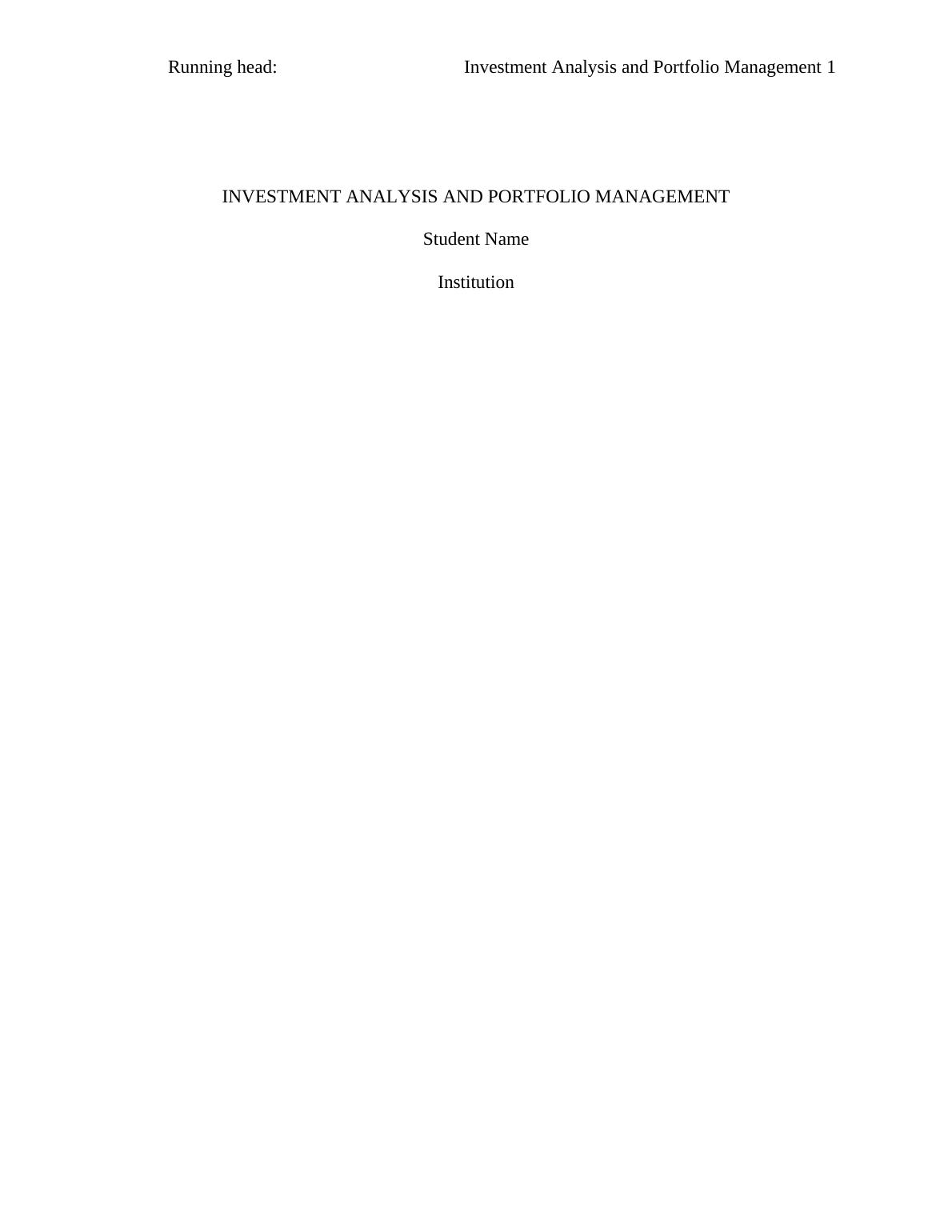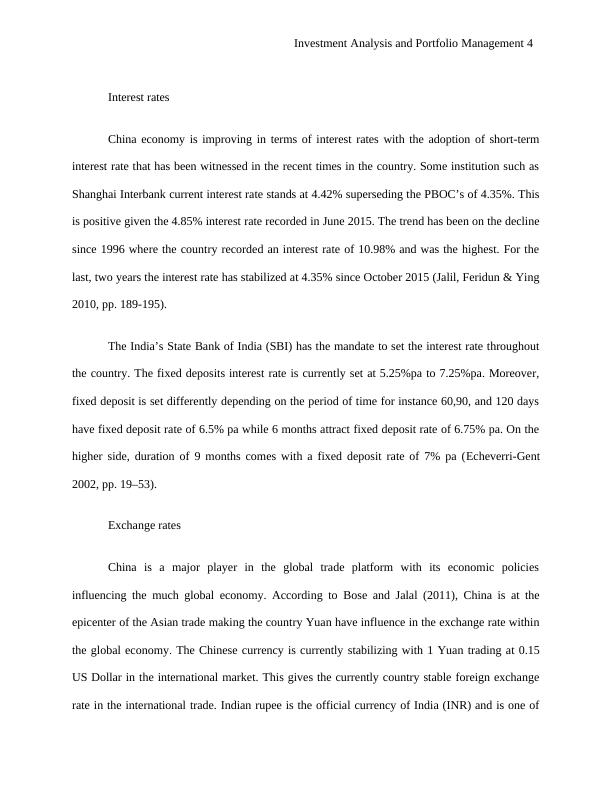Investment Analysis and Portfolio Analysis of India & China
16 Pages3640 Words82 Views
King's Own Institute (KOI), Australia
FIN702 - Investment and Portfolio Management (FIN702)
Added on 2019-11-08
Investment Analysis and Portfolio Analysis of India & China
King's Own Institute (KOI), Australia
FIN702 - Investment and Portfolio Management (FIN702)
Added on 2019-11-08
ShareRelated Documents
Running head: Investment Analysis and Portfolio Management 1INVESTMENT ANALYSIS AND PORTFOLIO MANAGEMENTStudent NameInstitution

Investment Analysis and Portfolio Management 2IntroductionEmerging economies refers to those economies of countries that are towards becomingadvance though. Two examples of these countries are China and India being the largest emergingmarket economies in the world. Emerging economies offers some of the best businessopportunities since these countries have large economies with the ability to advance. The twocountries have different and varied economic and environmental condition that influencesinvestment. Both China and India have registered different economic growth that has a direct orindirect effect on the return on capital invested. The robust economy that is supported by largepopulation size and good demography is vital for foreign investors willing to invest in the twocountries. The following paper gives the investment analysis and portfolio management withintwo emerging economies of China and India.The political environment in China has made limited progress in economic reforms. Thecurrent Communist Party show limited economic reforms that hinder both economic growth andtrade with the economic growth currently standing at 6.9%. This implies that since the partycame into power there are structural problems that are also tied to financial regulatoryinefficiencies jeopardizing the financial sector (Bode, Kane& Marcus 2005). Furthermore, theinfluence of Communist Party in the rule of law has reduced the dependence on the rule of lawpointing towards economic uncertainty growth giving integrity of Government Integrity 41.6.This is due to the vulnerability of the legal system that controls the trade regulation to thepolitical influence of Communist Party hence judicial effectiveness 60.7 (Thorp2010). Failure toreform the economic and financial sector has also resulted in debt either in the household,corporate, or the government. This political problem leaves the legitimacy of the Communist

Investment Analysis and Portfolio Management 3Party government in doubt since it fails to improve the living standards of the people as theypromised when coming to power.The government of India, on the other hand, is a democratically stable with annualgrowth of 7%. Bharatiya Janata Party has performed since its coming into power in 2014 withthe reinvigorating economy policy. This is coupled with technological advancement creating aclear distinction between the extremely wealthy and poor that exists in the Indian economy. Inaddition, the economic policies that are developed by Bharatiya Janata Party have facilitated thestruggle in the country’s diverse population. The government of India is currently developing tieswith other countries such as the USA giving the current good score in terms of foreign relations.Continuous pressure has made the judicial system in the country to be independent with goodadherence to the rule of law. The government integrity, therefore, remains Government Integrity44.3 due to understaffed of the judiciary with Judicial Effectiveness 44.4.Economic situationThe Indian open market gives the value of export and import leveling at 49% of GDP.According to reff, the average tariff that is applied to balance of trade currently is 6.2% withstate enterprise distorting the economy of India. Moreover, the government banking institutionsare the major players in the economy. These institutions also dominate the capital market sectordespite the liberalization of market efforts. The trade freedom is on the rise and, currently standsat 72.6% giving investment freedom and financial freedom equal rating of 40.0. India’s interestrate, on the other hand, is currently 8.1% p.a. this interest rate was made effective from thefinancial year 2016/2017.

Investment Analysis and Portfolio Management 4Interest ratesChina economy is improving in terms of interest rates with the adoption of short-terminterest rate that has been witnessed in the recent times in the country. Some institution such asShanghai Interbank current interest rate stands at 4.42% superseding the PBOC’s of 4.35%. Thisis positive given the 4.85% interest rate recorded in June 2015. The trend has been on the declinesince 1996 where the country recorded an interest rate of 10.98% and was the highest. For thelast, two years the interest rate has stabilized at 4.35% since October 2015 (Jalil, Feridun & Ying2010, pp. 189-195). The India’s State Bank of India (SBI) has the mandate to set the interest rate throughoutthe country. The fixed deposits interest rate is currently set at 5.25%pa to 7.25%pa. Moreover,fixed deposit is set differently depending on the period of time for instance 60,90, and 120 dayshave fixed deposit rate of 6.5% pa while 6 months attract fixed deposit rate of 6.75% pa. On thehigher side, duration of 9 months comes with a fixed deposit rate of 7% pa (Echeverri-Gent2002, pp.19–53). Exchange ratesChina is a major player in the global trade platform with its economic policiesinfluencing the much global economy. According to Bose and Jalal (2011),China is at theepicenter of the Asian trade making the country Yuan have influence in the exchange rate withinthe global economy. The Chinese currency is currently stabilizing with 1 Yuan trading at 0.15US Dollar in the international market. This gives the currently country stable foreign exchangerate in the international trade. Indian rupee is the official currency of India (INR) and is one of

End of preview
Want to access all the pages? Upload your documents or become a member.
Related Documents
LIBERALISATION IN INDIA: A REVIEW.lg...
|5
|492
|260
The Second Most populous country in Southern Asia - Indialg...
|3
|1002
|249
Feasibility of Foreign Direct Investment in Chinalg...
|14
|3077
|201
Comparison of India and Chinalg...
|4
|721
|82
Economic and Political Development Case Study 2022lg...
|7
|590
|44
China's Business Environment: A PESTEL Analysislg...
|5
|1533
|197
